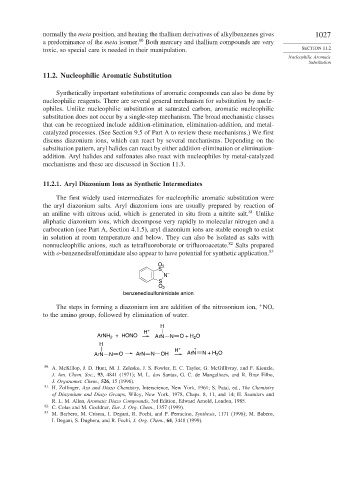Page 1051 - Advanced Organic Chemistry Part B - Reactions & Synthesis
P. 1051
normally the meta position, and heating the thallium derivatives of alkylbenzenes gives 1027
80
a predominance of the meta isomer. Both mercury and thallium compounds are very
toxic, so special care is needed in their manipulation. SECTION 11.2
Nucleophilic Aromatic
Substitution
11.2. Nucleophilic Aromatic Substitution
Synthetically important substitutions of aromatic compounds can also be done by
nucleophilic reagents. There are several general mechanism for substitution by nucle-
ophiles. Unlike nucleophilic substitution at saturated carbon, aromatic nucleophilic
substitution does not occur by a single-step mechanism. The broad mechanistic classes
that can be recognized include addition-elimination, elimination-addition, and metal-
catalyzed processes. (See Section 9.5 of Part A to review these mechanisms.) We first
discuss diazonium ions, which can react by several mechanisms. Depending on the
substitution pattern, aryl halides can react by either addition-elimination or elimination-
addition. Aryl halides and sulfonates also react with nucleophiles by metal-catalyzed
mechanisms and these are discussed in Section 11.3.
11.2.1. Aryl Diazonium Ions as Synthetic Intermediates
The first widely used intermediates for nucleophilic aromatic substitution were
the aryl diazonium salts. Aryl diazonium ions are usually prepared by reaction of
an aniline with nitrous acid, which is generated in situ from a nitrite salt. 81 Unlike
aliphatic diazonium ions, which decompose very rapidly to molecular nitrogen and a
carbocation (see Part A, Section 4.1.5), aryl diazonium ions are stable enough to exist
in solution at room temperature and below. They can also be isolated as salts with
nonnucleophilic anions, such as tetrafluoroborate or trifluoroacetate. 82 Salts prepared
with o-benzenedisulfonimidate also appear to have potential for synthetic application. 83
O 2
S
N –
S
O 2
benzenedisulfonimidate anion
+
The steps in forming a diazonium ion are addition of the nitrosonium ion, NO,
to the amino group, followed by elimination of water.
H
H +
ArNH + HONO ArN N O + H 2 O
2
H
H + +
ArN N O ArN N OH ArN N + H O
2
80 A. McKillop, J. D. Hunt, M. J. Zelesko, J. S. Fowler, E. C. Taylor, G. McGillivray, and F. Kienzle,
J. Am. Chem. Soc., 93, 4841 (1971); M. L. dos Santas, G. C. de Mangalhaes, and R. Braz Filho,
J. Organomet. Chem., 526, 15 (1996).
81
H. Zollinger, Azo and Diazo Chemistry, Interscience, New York, 1961; S. Patai, ed., The Chemistry
of Diazonium and Diazo Groups, Wiley, New York, 1978, Chaps. 8, 11, and 14; H. Saunders and
R. L. M. Allen, Aromatic Diazo Compounds, 3rd Edition, Edward Arnold, London, 1985.
82 C. Colas and M. Goeldner, Eur. J. Org. Chem., 1357 (1999).
83
M. Barbero, M. Crisma, I. Degani, R. Fochi, and P. Perracino, Synthesis, 1171 (1998); M. Babero,
I. Degani, S. Dughera, and R. Fochi, J. Org. Chem., 64, 3448 (1999).

